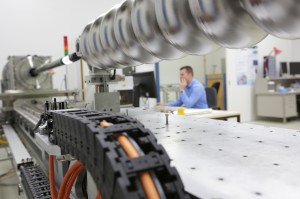
One lab: high-gradient cavities are now checked and treated in one single workshop at DESY. Image: DESY, Dirk Nölle
Cavity experts always have one goal in mind: to reach a higher gradient for the superconducting accelerator structures – in serial production. The cavity production for the X-ray laser European XFEL runs at full speed. However, the precondition for industrial production of the cavities for the International Linear Collider is to reliably obtain the intended gradient of 31.5 megavolts per metre. In fact, some of the European XFEL cavities already reach this value, but the yield of ILC-compatible cavities is still too small.
As a step to reach higher gradients, scientists at DESY have brought together under one roof all inspection and processing machines in the newly opened ILC HiGradeLab. “We will pursue two approaches in the laboratory,” said Aliaksandr Navitski from the DESY linear collider group FLA. “For one thing, we want to understand where defects occur in the cavities’ production.” For this aim, the experts use various inspection techniques, including the OBACHT inspection robot (DESY inForm 5/11) or the replica method that produces a copy of the cavity surface. Defects, for example imperfect welding seams, obstruct the optimal diffusion of the electromagnetic field in the cavity and inhibit the optimal gradient. “If we understand where problems occur during the production process we have a better chance of eliminating tem,” explained Navitski.
The other approach is to optimise existing cavities. “For this purpose, we are testing two additional methods. One of these is a local grinding and the other a polishing process called centrifugal barrel polishing,” Navitski said. The latter submits the cavities to a polishing process in a centrifuge with different polishing agents, taking up to four steps over a period of up to 40 hours. “With the close interlocking of our inspection and processing tools, we expect a major progress in reliably reaching high gradients – first of all for the industrial production of ILC cavities,” Navitski summarised. One goal has already been achieved today: the inspection tools ensure high quality of the European XFEL cavities.
This story first appeared in DESY inForm.

Recent Comments